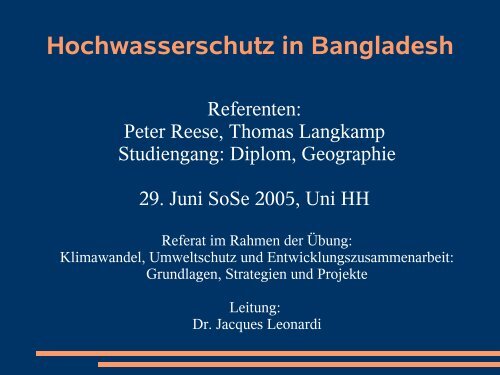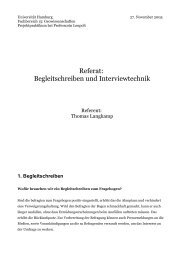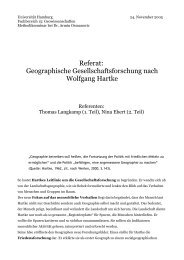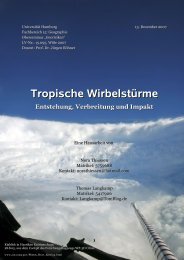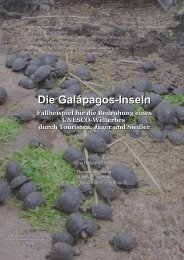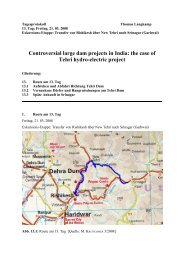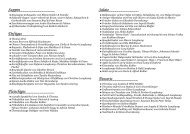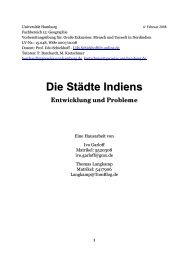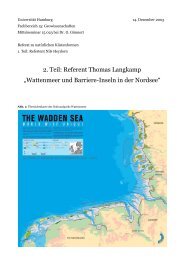Hochwasserschutz in Bangladesh - TomBlog
Hochwasserschutz in Bangladesh - TomBlog
Hochwasserschutz in Bangladesh - TomBlog
- No tags were found...
Create successful ePaper yourself
Turn your PDF publications into a flip-book with our unique Google optimized e-Paper software.
<strong>Hochwasserschutz</strong> <strong>in</strong> <strong>Bangladesh</strong>Referenten:Peter Reese, Thomas LangkampStudiengang: Diplom, Geographie29. Juni SoSe 2005, Uni HHReferat im Rahmen der Übung:Klimawandel, Umweltschutz und Entwicklungszusammenarbeit:Grundlagen, Strategien und ProjekteLeitung:Dr. Jacques Leonardi
GliederungWir● stellen das Projekt und se<strong>in</strong>en Kontext kurz vor●beleuchten die Hochwasser-Problematik●zeigen dann detailliert die Maßnahmen, Bautenund Probleme des Projekts●fassen die Evaluation der Verantwortlichenzusammen●sagen unsere eigene Me<strong>in</strong>ung
Das Projekt:secondary towns <strong>in</strong>tegrated floodprotection project● Integriertes <strong>Hochwasserschutz</strong>-Projekt für 6sekundär betroffener Städte <strong>in</strong> <strong>Bangladesh</strong>●<strong>in</strong>sgesamt 1,15 Millionen E<strong>in</strong>wohnern●e<strong>in</strong>es von bisher 31 Wassermanagement-Projekten<strong>in</strong> <strong>Bangladesh</strong>
Das Projekt●Der Flut-Aktions-Plan (FAP von 1989) derRegierung identifizierte 15 sekundäre Städte.●Den übrigen 9 Städten wird nun <strong>in</strong> der laufendenPhase 2 des Projektes geholfen.●primär betroffen: Hauptstadt Dhaka (91er Projektfür 92 Mio. $)
ProblematikÜberflutungen s<strong>in</strong>d e<strong>in</strong> ständiges Problem im dichtbesiedelten <strong>Bangladesh</strong>! (fast 4fache Dichte Deutschlands)
Problematik●Sommermonsun (Juni - September): ImBereich des GBM-Beckens enorme Niederschläge●Über 90% des GBM-Beckens liegen außerhalb<strong>Bangladesh</strong>s.
Problematik●20% des Landes werden im Schnitt jährlichüberflutet●70%, wenn sich die Hochwasser aller drei FlüsseüberlappenBeispiel: 1987/88 und 1998Fluttypen●●●●Tide-bee<strong>in</strong>flusste FlutFlussflutRegenflutSpr<strong>in</strong>gflut
ProblematikVerschlechterung der Überflutungssituation seit1950●●●starker Anstieg der Flusswasserspiegelhöhere ökonomische Schäden bei Flutenhöhere Anzahl betroffener Menschen? Ist der Klimawandel schuld?Fakt: Temperaturanstieg um 0,5°C
ProblematikMeeresspiegelanstieg: jährlich 7mmKe<strong>in</strong> Niederschlaganstieg im GBM!Anstieg der Probleme durch anthropogenenE<strong>in</strong>fluss auf Boden und Vegetation– Waldrodung– Urbanisierung! Bevölkerungsexplosion!
Problematik●Waldrodung: im gesamten GBM-Bas<strong>in</strong>– Feuerholz– Ackerflächen●●In Nepal > 50% des Ur-Waldes gerodet– speziell Hangerosion Degradation der BödenMio. t Sediment werdenFlussabwärts gespült (Tafel)In <strong>Bangladesh</strong> 35% des Waldes gerodet imVergleich 1973und heute.
ProblematikUrbanisierung:● E<strong>in</strong>deichung / Verschmälerung der Flüsse(Schaffung von Siedlungen und Ackerflächen)– Beispiel: 5695km Deich errichtet– Beispiel: Durchschnittsbreite Ganges 1973: 1,3 km1985: 1 kmAbnahme der Wasserspeicher-Kapazität <strong>in</strong> Flüssen
Problematik●●●ungeplante Urbanisierung– fehlende Infrastrukturke<strong>in</strong>e Wasserspeicher-Kapazität des Bodens– rasantes Abflussverhalten führt schnell zuWasseraufstauungenHygiene– 50% der Stadt-Bevölkerung lebt <strong>in</strong> Slums– 30% an der Grenze zum Hungertod
BevölkerungswachstumWaldrodungUrbanisierungverstärkterSedimenttransportE<strong>in</strong>deichung /FlussverschmälerungFlussbetterhöhung, Wasserspiegelanstieg undverm<strong>in</strong>derte Wasserspeicher-KapazitätÜberflutungen
Maßnahmen●●●Okt. 1990: Kredite bewilligt, PlanungsstartMai 1993: Beg<strong>in</strong>n (57 Monate veranschlagt)Dez. 2000: Ende (tatsächliche Dauer: 92 Monate)● Gesamtkosten: 70 Mio. $, davon gut 50 Mio. $Kredit von der Asiatischen Entwicklungsbank(ADB; 3. Engagement)● erwartete Kosten Phase 2: 130 Mio. $, 80 Mio. $von der ADB bis Juni 2009
Maßnahmen1. städtischer <strong>Hochwasserschutz</strong> (Teil A: 24 Mio. $):● Bau und Ausbesserung von Deichen● Schutzmauern● Flussufer-Erosionsschutz undFlussufer-Verkleidungen2. Entwässerungsmaßnahmen (Teil B: 20 Mio. $)● Gräben● Abwasserrohre
Maßnahmen3. Verbesserung städtischer Dienstleistungen undInfrastrukturen <strong>in</strong>sbesondere <strong>in</strong> den starkbetroffenen Slums (Teil C: 7 Mio. $)● Müll- und Abwasserentsorgung / Kanalisation● öffentliche Toiletten
Zu 3.: Kläranlangen(septic tanks)
Zu 3.: Tr<strong>in</strong>kwasserversorgung, Wasserfilteranlagenbzw. Sickergruben (soak pits)
Bau e<strong>in</strong>erSickergrube
Bau e<strong>in</strong>erSickergrube
Maßnahmen4. Logistik (Teil D: 5 Mio. $)● Alle<strong>in</strong> 3 Mio. $ für Vermessung und Kartierung● Management, Beratung, Umweltschutz, Monitor<strong>in</strong>g,Sozioökonomische Berichte● Entwicklung von Geme<strong>in</strong>schaftsprogrammen, umdie Bevölkerung zu beteiligen● <strong>in</strong>stitutionelle / politische Weiterentwicklung
Maßnahmen:ProblemeVerzögerungen durch ungeplante Kosten von 14Mio. $ wegen:● bürokratischem Prüfungswirrwar,● personellen Engpässen● nicht vorhergesehenen F<strong>in</strong>anzkosten, wie Inflation● politischen Unruhen und● Wetterproblemen (Flutschäden 1998: 2 Mio. $ |Starkregen)
502IEEE TRANSACTIONS ON SYSTEMS, MAN, AND CYBERNETICS, VOL. 21, NO. 3, MAYIJUNE 1991what feels pleasurable, and what hurts.It is also widely known that emotions affect memory.Emotionally traumatic experiences are remembered <strong>in</strong> vividdetail for years, while emotionally nonstimulat<strong>in</strong>g everydaysights and sounds are forgotten with<strong>in</strong> m<strong>in</strong>utes after they areexperienced.Emotions are popularly believed to be someth<strong>in</strong>g apartfrom <strong>in</strong>telligence-irrational, beyond reason or mathematicalanalysis. The theory presented here ma<strong>in</strong>ta<strong>in</strong>s the opposite.In this model, emotion is a critical component of biological<strong>in</strong>telligence, necessary for evaluat<strong>in</strong>g sensory <strong>in</strong>put, select<strong>in</strong>ggoals, direct<strong>in</strong>g behavior, and controll<strong>in</strong>g learn<strong>in</strong>g.It is widely believed that mach<strong>in</strong>es cannot experience emotion,or that it would be dangerous, or even morally wrong toattempt to endow mach<strong>in</strong>es with emotions. However, unlessmach<strong>in</strong>es have the capacity to make value judgments (i.e., toevaluate costs, risks, and benefits, to decide which course ofaction, and what expected results, are good, and which are bad)mach<strong>in</strong>es can never be <strong>in</strong>telligent or autonomous. What is thebasis for decid<strong>in</strong>g to do one th<strong>in</strong>g and not another, even toturn right rather than left, if there is no mechanism for mak<strong>in</strong>gvalue judgments? Without value judgments to support decisionmak<strong>in</strong>g, noth<strong>in</strong>g can be <strong>in</strong>telligent, be it biological or artificial.Some examples of value state-variables are listed below,along with suggestions of how they might be computed. Thislist is by no means complete.Good is a high level positive value state-variable. It may beassigned to the entity frame of any event, object, or person.It can be computed as a weighted sum, or spatiotemporal<strong>in</strong>tegration, of all other positive value state-variables assignedto the same entity frame.Bad is a high level negative value state-variable. It can becomputed as a weighted sum, or spatiotemporal <strong>in</strong>tegration,of all other negative value state-variables assigned to an entityframe.Pleasure: Physical pleasure is a mid-level <strong>in</strong>ternal positivevalue state-variable that can be assigned to objects, events,or specific regions of the body. In the latter case, pleasuremay be computed <strong>in</strong>directly as a function of neuronal sensory<strong>in</strong>puts from specific regions of the body. Emotional pleasureis a high level <strong>in</strong>ternal positive value state-variable that can becomputed as a function of highly processed <strong>in</strong>formation aboutsituations <strong>in</strong> the world.Pa<strong>in</strong>: Physical pa<strong>in</strong> is a low level <strong>in</strong>ternal negative valuestate-variable that can be assigned to specific regions of thebody. It may be computed directly as a function of <strong>in</strong>puts frompa<strong>in</strong> sensors <strong>in</strong> specific regions of the body. Emotional pa<strong>in</strong> isa high level <strong>in</strong>ternal negative value state-variable that may becomputed <strong>in</strong>directly from highly processed <strong>in</strong>formation aboutsituations <strong>in</strong> the world.Success-observed is a positive value state-variable thatrepresents the degree to which task goals are met, plus theamount of benefit derived therefrom.Success-expected is a value state-variable that <strong>in</strong>dicates thedegree of expected success (or the estimated probability ofsuccess). It may be stored <strong>in</strong> a task frame, or computeddur<strong>in</strong>g plann<strong>in</strong>g on the basis of world model predictions. Whencompared with success-observed it provides a base-l<strong>in</strong>e formeasur<strong>in</strong>g whether goals were met on, beh<strong>in</strong>d, or ahead ofschedule; at, over, or under estimated costs; and with result<strong>in</strong>gbenefits equal to, less than, or greater than those expected.Hope is a positive value state-variable produced whenthe world model predicts a future success <strong>in</strong> achiev<strong>in</strong>g agood situation or event. When high hope is assigned to atask frame, the BG module may <strong>in</strong>tensify behavior directedtoward complet<strong>in</strong>g the task and achiev<strong>in</strong>g the anticipated goodsituation or event.Frustration is a negative value state-variable that <strong>in</strong>dicatesan <strong>in</strong>ability to achieve a goal. It may cause a BG module toabandon an ongo<strong>in</strong>g task, and switch to an alternate behavior.The level of frustration may depend on the priority attached tothe goal, and on the length of time spent <strong>in</strong> try<strong>in</strong>g to achieve it.Love is a positive value state-variable produced as a functionof the perceived attractiveness and desirability of an object orperson. When assigned to the frame of an object or person,it tends to produce behavior designed to approach, protect, orpossess the loved object or person.Hate is a negative value state-variable produced as a functionof pa<strong>in</strong>, anger, or humiliation. When assigned to the frameof an object or person, hate tends to produce behavior designedto attack, harm, or destroy the hated object or person.Comfort is a positive value state-variable produced by theabsence of (or relief from) stress, pa<strong>in</strong>, or fear. Comfort can beassigned to the frame of an object, person, or region of spacethat is safe, shelter<strong>in</strong>g, or protective. When under stress or <strong>in</strong>pa<strong>in</strong>, an <strong>in</strong>telligent system may seek out places or persons withentity frames that conta<strong>in</strong> a large comfort value.Fear is a negative value state-variable produced when thesensory process<strong>in</strong>g system recognizes, or the world modelpredicts, a bad or dangerous situation or event. Fear may beassigned to the attribute list of an entity, such as an object,person, situation, event, or region of space. Fear tends toproduce behavior designed to avoid the feared situation, event,or region, or flee from the feared object or person.Joy is a positive value state-variable produced by therecognition of an unexpectedly good situation or event. It isassigned to the self-object frame.Despair is a negative value state-variable produced by worldmodel predictions of unavoidable, or unend<strong>in</strong>g, bad situationsor events. Despair may be caused by the <strong>in</strong>ability of thebehavior generation planners to discover an acceptable planfor avoid<strong>in</strong>g bad situations or events.Happ<strong>in</strong>ess is a positive value state-variable produced bysensory process<strong>in</strong>g observations and world model predictionsof good situations and events. Happ<strong>in</strong>ess can be computed asa function of a number of positive (reward<strong>in</strong>g) and negative(punish<strong>in</strong>g) value state-variables.Confidence is an estimate of probability of correctness. Aconfidence state-variable may be assigned to the frame of anyentity <strong>in</strong> the world model. It may also be assigned to the selfframe, to <strong>in</strong>dicate the level of confidence that a creature has <strong>in</strong>its own capabilities to deal with a situation. A high value ofconfidence may cause the BG hierarchy to behave confidentlyor aggressively.Uncerta<strong>in</strong>ty is a lack of confidence. Uncerta<strong>in</strong>ty assignedto the frame of an external object may cause attention to be
Evaluation:sozioökonomische Veränderungen●52% <strong>in</strong> Habiganj65% <strong>in</strong> Khulna> 80% <strong>in</strong> den vier anderen Städten berichten vonbesserer Mobilität●49% <strong>in</strong> Khulna95% <strong>in</strong> den übrigen fünf Städten berichten vone<strong>in</strong>em Rückgang vom Stauwasser verursachtenKrankheiten.
Evaluation:sozioökonomische VeränderungenProbleme:●●●●Siedeln von Menschen auf der Flussseite desDeichesSlumverbesserung mit Projektende e<strong>in</strong>gestelltMüllproblem: ungesicherte DeponienF<strong>in</strong>anzierung durch SteuernZwei Städte haben e<strong>in</strong>e positive F<strong>in</strong>anzbilanz
Evaluation:F<strong>in</strong>anzen
Evaluation: Nachhaltigkeit●●Stadtverwaltung kann für Kosten derInstandhaltung auf Dauer nicht aufkommen.Projektgeme<strong>in</strong>schaften müssen stattdessen fürInstandhaltung motiviert werden.●●Die dauerhafte Wirksamkeit der Bauten istungewiss.Müllproblem soll nachträglich <strong>in</strong> Angriffgenommen werden.Projekt wird <strong>in</strong>sgesamt als Erfolg gewertet.Zuversicht für Phase 2, da behördliche Prozessee<strong>in</strong>geübt s<strong>in</strong>d.
L<strong>in</strong>ks und Quellenhttp://www.reliefweb.<strong>in</strong>t/rw/RWB.NSF/db900SID/JCDR-67AUT4?OpenDocumenthttp://www.lcgbangladesh.org/<strong>in</strong>ventory/9_<strong>in</strong>ventory.pdfhttp://www.meghbarta.org/2001/june/dvlp.htmlhttp://www.bssnews.net/<strong>in</strong>dex.php?genID=BSS-03-2004-12-02&id=7http://www.bssnews.net/<strong>in</strong>dex.php?genID=BSS-03-2004-12-02&id=7--> pdfs speziell zum Projekthttp://www.adb.org/Documents/PPARs/BAN/ppa_ban_24096.pdfhttp://www.asiandevbank.org/Documents/RRPs/BAN/rrp-ban-26427.pdfhttp://www.asiandevbank.org/Documents/RRPs/BAN/rrp-R18092.pdfhttp://www.adb.org/Media/Articles/2003/1307_Flood_Mitigation_Project_for_<strong>Bangladesh</strong>s_Secondary_Towns/default.asphttp://www.adb.org/Media/Articles/2004/5357_bangladesh_flood_protection_sav<strong>in</strong>g_lives/http://www.adb.org/Media/Articles/2004/5494_bangladesh_flood_threat_monitor_unit/default.asphttp://www.adb.org/Media/Articles/2003/1416_<strong>Bangladesh</strong>_Loan_Sign<strong>in</strong>gs_for_Five_<strong>Bangladesh</strong>_Projects/default.asphttp://www.adb.org/Media/Articles/2002/528_<strong>Bangladesh</strong>_Billion_Loan/default.asphttp://www.adb.org/media/Articles/2005/7711_<strong>Bangladesh</strong>_water_issues/default.asphttp://www.wcmap.org/images/soakpits.jpghttp://cpreec.org/04_articles/harvest<strong>in</strong>g_ra<strong>in</strong>water/harvest<strong>in</strong>g_ra<strong>in</strong>water.htmlhttp://www.foxhylleng<strong>in</strong>eer<strong>in</strong>g.com/mali/chapter10.htmlhttp://www.schoolsanitation.org/BasicPr<strong>in</strong>ciples/WaterFlushToilets.htmlhttp://www.agry.purdue.edu/landuse/septic/cttpp2/images/baffle.gifhttp://www.nutriteck.com/aqualogics/septic.htmlhttp://ossf.tamu.edu/ossf_two_compartment_septic_tank.jpghttp://www.agnr.umd.edu/users/wye/personel/Miller/septic.htmlhttp://www.dfidbangladesh.org/images/Flood03.jpghttp://www.caritas.org.au/images/emergencies/bangladesh_appeal_2.jpghttp://www.<strong>in</strong>novations-report.com/bilder_neu/5678_flood.jpghttp://www.thedailystar.net/2004/07/26/d407261501112.htm
Fazit„<strong>Bangladesh</strong> is undergo<strong>in</strong>g 50 years of water development and flood control projectthrough <strong>in</strong>ternational development agencies. But the suffer<strong>in</strong>gs of people are notm<strong>in</strong>imized. On the other hand development projects generate successive projects.The projects, justified mostly <strong>in</strong> terms of <strong>in</strong>creased cereal crop production (WorldBank 1997), has been created very twisty scenario. 50 per cent of the populationlive below poverty l<strong>in</strong>e. Agricultural activities mostly depend on hybrid seed,fertilizer, and <strong>in</strong>secticide. On the other hand severity of flood<strong>in</strong>g <strong>in</strong>creased.Enormous Dead River, dra<strong>in</strong>age congestion, water logg<strong>in</strong>g, bio-diversity loss andhuge debt burden are common feature of our country after pass<strong>in</strong>g 5 decades ofthese development exercises.“Quelle: http://www.meghbarta.org/2001/june/dvlp.html


